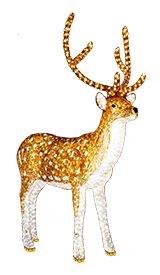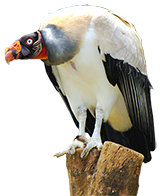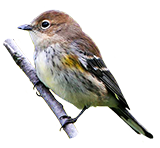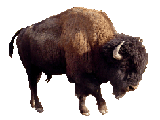Learn About the World's Fastest Land Animal: The Chetah
The cheetah is famous for being one of the nature's finest predators. This page of cheetah facts will teach you everything you might ever want to know about these incredible animals.
The cheetah's biggest claim to fame is its speed – it's the fastest land mammal on Earth. It's one of the 'big cats' (others in this category are the tiger, the lion, the leopard and the panther) but it's quite different from its other big cat relatives in many important ways.
By the way, the cheetah is also called gepard, or guerpardo, guérpard, just to clear things up.
This page with facts about cheetahs is great to use together with the other page on this site about cheetahs, Cheetah Pictures, where you will find a lot of beautiful cheetah photos and drawings.
Cheetah Speed
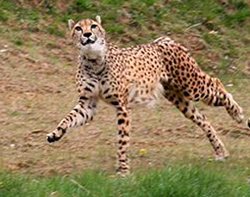 As already mentioned above, the cheetah is the fastest living land
animal.
As already mentioned above, the cheetah is the fastest living land
animal.
But in animal terms, the cheetah is a sprinter, not a long
distance runner.
In fact, over a long enough distance the
second-fastest animal – the pronghorn – would beat a cheetah in a
race.
The cheetah's biggest strength is its rapid acceleration,
being able to hit top speed in just a few seconds.
When a cheetah is
running at full speed it covers up to 31 meters per second – that's
a shocking hundred feet in only a second. That's about a third of an
American football field – in only one second.
This makes the cheetah
roughly three times faster than the current 100 meter sprint world
record holder, Usain Bolt. When cheetahs are moving at full pace,
they only need to make a footfall every 23 feet (7 meters) and only
have one foot on the ground at a time.
But remember – the cheetah is the fastest living land animal in the world, but not the fastest animal. That title is taken by the peregrine falcon, which can dive at speeds of up to 202 miles per hour – about 325 kilometers per hour, making its top speed over one and a half times faster than that of the cheetah.
Here is a vide of the cheetah running, in slow motion:
----------------------------------------
Let's look at some of the most fascinating and funny facts about cheetahs:
how they behave, what they eat, where they live and more.
Basic Cheetah Facts
Here are a few of the most essential cheetah facts to get you started:
 Cheetahs can run up to 75 miles per hours
– that's about 120 kilometers per hour! (The second fastest animal
on land, the pronghorn, can only run about 53 miles per hour)
Cheetahs can run up to 75 miles per hours
– that's about 120 kilometers per hour! (The second fastest animal
on land, the pronghorn, can only run about 53 miles per hour)
Cheetahs are often confused with leopards,
because both these big cats have spots. The main differences are
that cheetahs are obviously faster, they're slightly smaller, and
leopards are all around more muscular and 'stronger' than cheetahs.
(Just to make matters more confusing, the British in India used to
called cheetahs the 'Hunting-Leopard.')
Cheetahs can't fully retract their claws (pull them up into their
foot pads) the way a normal house cat can
Top lifespan for a cheetah in the wild is about 20 years – but a
study found that the average is only about 7 years
Cheetahs weigh between 110 and 140 pounds (50 to 63
kilograms – leopards, on the other hand, can easily weigh over 220
pounds or 100 kilograms)
Despite its
high top speeds, cheetahs only usually reach just over half that
speed when chasing their prey (because they're so much faster than
most of the animals they hunt, they don't need to use all their
energy running full speed)
Cheetahs
have very good eyesight
Cubs take
about 95 days to develop inside the mother and female cheetahs
usually have between three and five cubs at a time
What does 'cheetah' actually mean? It originates
from India and comes from a word that translates to 'spotted one'
Adult cheetahs grow up to around 53
inches long from nose to the base of the tail (about 135
centimeters)
Hopefully these facts answered some of the main questions in your
mind about cheetahs.
Now let's zoom in and take a closer look at the
way cheetahs behave in the wild.
Facts about Cheetah Behavior
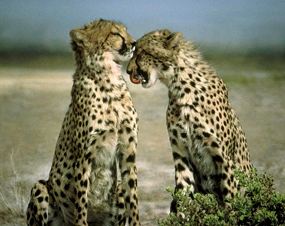 Cheetahs are quite unusual in many of their behaviors.
Cheetahs are quite unusual in many of their behaviors.
Many large
predators, like wolves and lions, live out their lives in packs.
Cheetahs, on the other hand, are often on their own or in very small
groups.
When a mother has cubs, she will raise them on her own
without any help from the male.
Male cheetahs roam on their own or
in groups with other males, but they don't take part in family
groups with females and cubs.
However, male groups are usually (but
not always) made up of brothers. Male cheetah groups don't usually
grow larger than 3 in number.
 The bond between a cheetah mother and her cubs is very important,
because the cubs learn all their hunting skills from her.
The bond between a cheetah mother and her cubs is very important,
because the cubs learn all their hunting skills from her.
Without
plenty of time spent with their mother learning to hunt (and play
fighting with their siblings) cubs have little chance of growing up
and surviving.
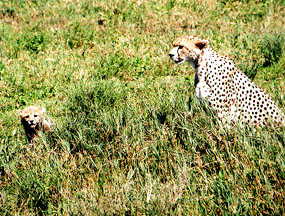 The fact that the cheetah mother has to hunt, gather food and care
for her cubs on her own has some important impacts.
The fact that the cheetah mother has to hunt, gather food and care
for her cubs on her own has some important impacts.
For starters,
the time cheetahs carry cubs in the womb is short and the size of
cubs when they're born is very small.
This is because if the cheetah
mother was pregnant for a long time with large, growing cubs, it
would make impossible for her to run fast enough to catch her food.
As a result, cubs are not very developed when they are born and the mother has to be careful to hide them in a safe place when they're very young so she can hunt and bring food back to them.
The cheetah's eyesight is an important part of the way it hunts.
Because cheetahs can see so well, they're able to spot prey (even
camouflaged prey) before the prey sees them.
This makes it possible
for the cheetah to get close enough to launch a 'surprise attack.'
While the cheetah is mostly known for its high speed chases, the 'stalk'
is an equally important part of the cheetah's hunting strategy.
The
cheetah's stalk looks similar to the way a common house cat will
stalk a bird: body kept low to the ground, head steady and eyes
fixed forward on the prey. This allows the cheetah to make the most
of the cover of the grass.
When the cheetah is about 300 feet away from its target (90 meters)
it launches its sprint attack.
Many people have a vision of the
cheetah leaping on an animal and biting it straight away, but this
is not how it usually happens.
The cheetah will often try to knock
the animal off balance first by tripping it or simply running into
it at high speed, then once the prey is stunned the cheetah will
bite down on the neck.
Cheetah Habitat – Where Do Cheetahs Live?
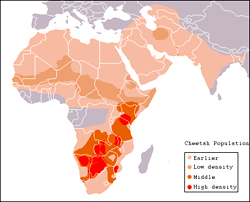 Cheetahs in the wild these days are found throughout most of Africa,
the Middle East and the Afghanistan/India region.
Cheetahs in the wild these days are found throughout most of Africa,
the Middle East and the Afghanistan/India region.
They were once
common in all these areas of the world, but now the largest cheetah
populations are only in Africa.
The cheetah has already disappeared
from the wild in many parts of the world where it used to be seen
often.
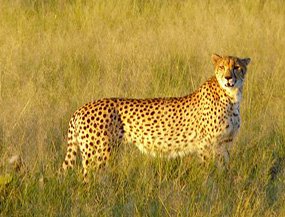 The largest cheetah population by country is believed to be Namibia,
which has about 2500 wild cheetahs.
The largest cheetah population by country is believed to be Namibia,
which has about 2500 wild cheetahs.
That gives you some idea of how
endangered the cheetah has become.
It's believed there are only a few hundred dotted around parts of the Middle East. Altogether the most recent estimates have put the world population at around 10,000 in the wild.
In terms of the habitat cheetahs like, they prefer open spaces on
the savanna and the plains.
These areas provide the perfect hunting
ground for cheetahs, with tall grass for camouflage and flat land
where the cheetah can make the most of its speed advantage.
What Do Cheetahs Eat?
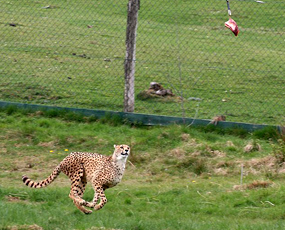 Unlike many animals on the savanna, cheetahs are not scavengers.
Unlike many animals on the savanna, cheetahs are not scavengers.
They're hunters – they catch all their food (as you might expect,
since they're the fastest animals out there!). They are also
strictly carnivores – in other words, meat eaters.
Also, unlike lions which sometimes target large animals like giraffes and elephants, cheetahs prefer smaller prey: things like hares, antelope and gazelles.
Most of the animals they catch weigh less than 88 pounds (around 40 kilograms). They also eat impala and springbok – they type of animals cheetah preys on depends where in the world it lives.
Groups of males hunting together will sometimes take on larger animals.
Another major difference between lions and cheetahs is that cheetahs hunt mostly during the day whereas lions tend to hunt at night.
The cheetah doesn't hunt in large packs the way lions do.
Because
cheetahs are much more solitary animals, they need to rely on
stealth and speed to catch their prey – they can't use cooperative
attacks with big numbers of attackers the way lions do.
This is why
the cheetah's camouflage (its spots, which help it blend in and hide
in the tall grass) is so important. Mother cheetahs typically do all
their hunting alone, whereas male groups will act as a team – but
again, the group size doesn't usually exceed two or three.
A lion
pride, by contrast, can often number up to 20.
Cheetah Facts: Cheetah Enemies
We often think of big cats like the cheetah having no enemies, but that's not true.
Not only through hunting of cheetahs for their skins over
many years, but more importantly through habitat destruction.
The
biggest reason cheetahs are so rare in the Middle East and Asia
nowadays is the simple lack of habitat as human beings continue to
destroy our natural surroundings and disrupt ecosystems.
Unfortunately, many farmers in Africa also blame cheetahs for
killing livestock like goats, and will shoot cheetahs on sight
because of this.
This is a huge problem with some sub-species of
cheetah now numbering less than 500 in the wild.
But cheetahs are also vulnerable to attack from those other famous big cats, the lions. Lions are much bigger and more powerful than cheetahs, and although cheetahs can outrun a single lions, the way lions work together as a pack can make them very dangerous for a lone cheetah or some unprotected cheetah cubs.
The biggest way in
which lions affect cheetahs is through food theft. Lions will wait
for a cheetah to make a kill – and then move in a steal it.
A
cheetah is not willing to fight a pack of lions over some food, so
the cheetah usually abandons the kill. But more generally, lions and
cheetahs are often competing in the same territory for the same food
sources, which makes it harder for cheetahs to catch the food they
need.
Another animal that has a tendency to steal cheetah kills is the
hyena.
Like lions, hyenas work together in groups, but unlike lions
hyenas don't tend to catch their own food. Their survival strategy
is based around stealing and scavenging food from other predators.
African wild dogs, which are similar to hyenas, are also a threat to
the cheetah.
The leopard – the animal many people tend to confuse with a cheetah,
because of its spots – is also a threat to cheetahs. As you'll
recall from above, the leopard is much larger and stronger than the
cheetah.
Not only do they compete with food, but leopards will
sometimes kill cheetah cubs.
One other enemy of the cheetah you might not expect is the eagle. Eagles, because of their excellent eyesight and their ability to swoop down on their prey, can be a huge threat to unprotected cheetah cubs.
It's estimated that over 9 out of 10 cheetah cubs die in their first few weeks of life, killed off largely by hyenas and wild dogs, leopards, lions and eagles.
How Many Types of Cheetah Are There?
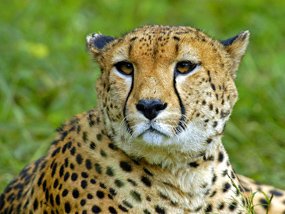 Cheetahs are only considered to be one species, but they can be
broken down into six different sub-species.
Cheetahs are only considered to be one species, but they can be
broken down into six different sub-species.
However, some cheetah
experts believe there's not enough difference between some of these
sub-species to deserve splitting them up.
The differences are very
tiny, and include things like the length of a cheetah's fur.
However, one sub-species that is well recognized is the king cheetah
because it has a very different spot pattern from other cheetahs.
In
particular, the king cheetah can be recognized by the three solid
back stripes that run along its back.
King cheetahs are very rare.
Other cheetah types include the Asiatic cheetah and the Sahara
cheetah.
As you might guess from the names, much of what makes these
cheetahs unique has to do with where they live. The Asiatic cheetah
is found in Iran and it also known as the Iranian cheetah.
They are
classified as critically endangered, with less than 100 left in the
wild.
The cheetah is currently classified as 'vulnerable' by major species protection organizations.
Many people think it would be tragic if
cheetahs were to disappear, but that it won't affect humans in any
major way.
But they don't understand the full impact extinctions of
animals have for every other living thing on Earth.
Because every animal is part of an 'ecosystem,' taking one or two species out of the system can threaten every other species because it changes the balance of nature. This alters the food chain and has big impacts on other animals including humans – we are still a part of nature, even though some people like to think otherwise!
This is why it's so important to preserve species and make sure creatures like the cheetah don't become extinct.
African Cheetahs of the Sahara
The more common name for it these days is the Northwest African cheetah.
It's unusual because all other sub-species of cheetah are not able to survive in the extremely harsh conditions of the Sahara Desert. This cheetah is able to survive by hunting at night rather than day time as most cheetahs do, so it doesn't have to suffer from the scorching desert sun during the day.
But beyond the simple fact of where it lives, these big cats look at lot different from other cheetahs – in fact, at first glance you would think you were looking at a skinny female lion rather than a cheetah. Sahara cheetahs have very faint spots and no spots at all on some parts of their bodies.
Like the Asiatic cheetah, the Sahara cheetah is classified as critically endangered. There are only 250 of these cheetahs left in the wild.
Cheetahs and Humans Throughout the Ages
The relationship between cheetahs and humans is a long one, stretching back as far as 5000 years into the past by some estimates. At the page, Cheetah Pictures you will find a drawing of a tamed cheetah in Ancient Egypt
Royalty in Africa and India used to keep cheetahs as pets and give
them to each other as gifts – live cheetahs, as well as cheetah
skins, were seen as a sign of high status.
A king in India kept
around 1000 cheetahs in a stable at one time, using them for hunting.
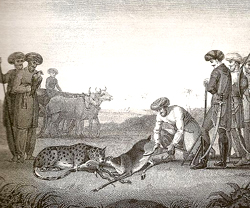 Although cheetahs have at times been kept as pets, it's important to
understand that they have never been domestic animals in the sense
of the cats and dogs we keep at home these days and farm animals
like cows and pigs.
Although cheetahs have at times been kept as pets, it's important to
understand that they have never been domestic animals in the sense
of the cats and dogs we keep at home these days and farm animals
like cows and pigs.
Many animals can be tamed enough to interact
with humans (such as lions in circus shows) but this does not mean
they are domestic animals.
It takes many decades of careful breeding
to get animals to a point where they are truly 'safe' to keep as
pets. This was demonstrated quite well when the famous Las Vegas
magician Roy Horn was attacked by one of his trained white tigers.
More Fun and Interesting Cheetah Information
Not enough cheetah facts for you yet? Here are some more strange tidbits of cheetah information to increase your knowledge even further:
Cheetahs can see their prey from up to 3 miles away (about 5
kilometers)
The black lines that run down a cheetah's face from
the eyes are called 'tear marks' (this is another way to tell the
difference between leopards and cheetahs)
Cheetahs usually hunt
in the morning and evening, as the sun rises and sets
The
scientific name for cheetahs is 'Acinonyx jubatus'
Cheetahs use
their tails for balance and 'steering' when they sprint, the same
way a boat uses a rudder
Just like your everyday house cat,
cheetahs 'purr'
Now you can impress all your friends and family with your amazing list of cheetah facts!

Back to the top of this page about Cheetah Facts
Visit Homepage and other pages here on Clipartqueen related to this one:
| Homepage | Pictures of Cheetahs | Animal Facts | Pictures of Animals |
 |
 |
 |
 |
| site search by freefind |
Hot pages right now:
Free Christmas borders
Free Christmas Clipart
Christmas Tree Clipart
Christmas Silhouettes
Christmas Clipart
Christmas Coloring Pages
Christmas Cards
Winter Clipart
Fall Clipart

Umbrella Clipart
Snowman Clipart
Horse silhouettes
Victorian Silhouette
Bird Pictures
Space clip art
Koi Fish Drawings
Penguin clip art
Butterfly Clipart
Dinosaur Clip Art
Animal clip art
Tiger Clipart







